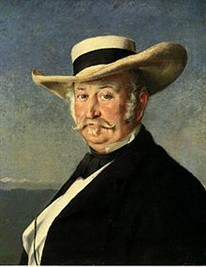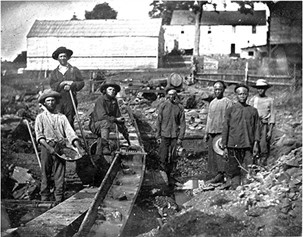John Augustus Sutter, an
entrepreneur's entrepreneur, created an empire for himself in
California after coming to America from Switzerland, but he was not
satisfied with his empire. (click here for more)
The Sacramento valley had given
Sutter a fresh start after a series of business failures in
Switzerland. After crossing the continent with one of
Fitzpatrick's wagon trains, Sutter had built a small empire of
50,000 acres of land, orchards, a trading post and a fort, all on
the present day site of the California state capitol.
What he needed now was a sawmill to produce lumber that could turn
more of his dreams into real things.

On Friday,
August 27, 1847, Sutter noted in his journal that he "made contract
and entered in partnership with James Marshall for a sawmill to be
built on the American fork." James Marshall, an amateur
millwright from Hope Township, New Jersey, set off with his
business partner, John Wimmer, to build Sutter a sawmill on the
American River, forty-five miles from his trading post on the
Sacramento River.
Forty-niners working a placer claim in the California gold
fields of the Sierra Nevada mountains.
On the morning of
January 19, 1848, Marshall was checking the millrace driving the
water wheel that powered the mill. Something shiny in the
bottom of the ditch caught his eye. "I reached my hand
down and picked it up; it made my
heart thump, for I was certain it was gold." The nugget he
found was the size of a small pea. This moment of private
astonishment would change the course of history. Marshall had
discovered gold on the south fork of the American River in
California. (In the end, he never made a cent on his
discovery.)
Sutter tried to keep a lid on the
news, but his efforts were no match for the lure of gold. As
Marshall and Sutter were waiting for the official assay, Marshall's
men were finding more nuggets at the site of the millrace, and it
wasn't long before other Californians got wind of the rumor (for
more on the 49'ers, click here).
The discovery
of gold in California, and the opening of the overland trail, were
two events that brought the Brule and Oglala Sioux into close
contact with a class of white people that was unlike any they had
previously met. With fur traders they shared many interests,
but with the gold diggers and agrarian settlers they had little in
common. These people hurried along the trail and
managed to devastate everything they touched, including grasslands
and rivers, streams and stands of timber.
By April of
1849, 30,000 Americans had set out for the California gold
fields by land. Twenty-five thousand more left by
clipper ships rounding Cape Horn. "Passengers on the clippers were
fed like hogs," wrote one gold seeker. The biscuits served to
passengers, wrote one landlubber, "were invested with black bugs
burrowing into it like woodchucks in a sand bank."
Others would
sail to Panama, transit the isthmus by foot, and hope to catch a
coastal steamer for the last leg up the west coast to
California.
It seemed the
entire nation was on the move, and many were on their way to
California, a development that terrified the California
Indians. The 1849 massacre of 130 Pomo men, women and
children who were fishing peacefully on a lake, was just the
beginning of the atrocities that would kill five in six California
Indians between 1850 and 1860. Whites declared open season on
California Indians and did not even attempt to stay within the
law.
Related People
Related Events
Related Flashpoints